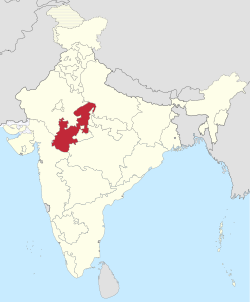This article needs additional citations for verification .(June 2007) |
| Madhya Bharat | |||||||||||
|---|---|---|---|---|---|---|---|---|---|---|---|
| State of India | |||||||||||
| 1948–1956 | |||||||||||
 Location of Madhya Bharat in India, 1951 | |||||||||||
| Capital | Gwalior | ||||||||||
| Area | |||||||||||
• 1881 | 194,000 km2 (75,000 sq mi) | ||||||||||
| Population | |||||||||||
• 1881 | 9,261,907 | ||||||||||
| History | |||||||||||
• Abolition of the Central India Agency | 1948 | ||||||||||
• Creation of Madhya Pradesh State | 1956 | ||||||||||
| |||||||||||
Madhya Bharat, also known as Malwa Union , [1] was an Indian state in west-central India, created on 28 May 1948 [2] from twenty-five princely states which until 1947 had been part of the Central India Agency, [3] with Jiwajirao Scindia as its Rajpramukh.
Contents
The union had an area of 46,478 square miles (120,380 km2). [4] Gwalior was made the capital and the first legislative assembly took place inside the Moti Mahal of Gwalior. [5] It was bordered by the states of Bombay (presently Gujarat and Maharashtra) to the southwest, Rajasthan to the northwest, Uttar Pradesh to the north, and Vindhya Pradesh to the east, and Bhopal State and Madhya Pradesh to the southeast. The population was mostly Hindu and Hindi-speaking. On 1 November 1956, Madhya Bharat, together with the states of Vindhya Pradesh and Bhopal State, was merged into Madhya Pradesh.